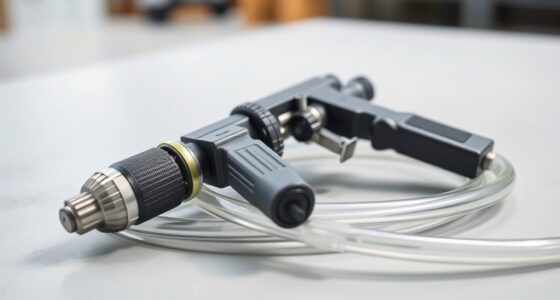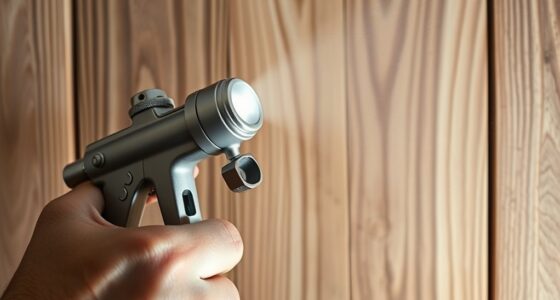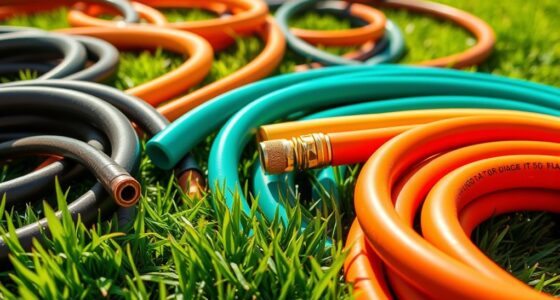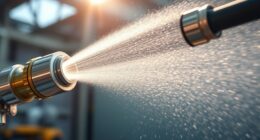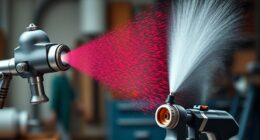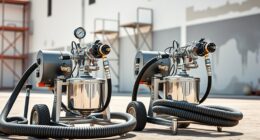To choose between DIY or pro sprayers, consider your skill level and project size. Beginners should start with simple handheld or pump sprayers that are lightweight and easy to operate. If you’re comfortable and tackling larger tasks, upgrade to small electric or airless models that handle more materials efficiently. As you gain experience, you can explore advanced and professional-grade sprayers for quicker, more precise work. Keep exploring further to find the perfect fit.
Key Takeaways
- Assess your experience with painting tools to determine if a simple handheld sprayer suffices or if a more advanced model is needed.
- Start with beginner-friendly sprayers for small projects to build confidence before upgrading to professional equipment.
- Match sprayer features (adjustable settings, power, capacity) with your project size and complexity for optimal results.
- Consider the frequency of use; occasional DIYers benefit from lightweight, easy-to-use models, while pros need durable, high-capacity sprayers.
- Learn basic spraying techniques and paint prep to ensure proper equipment selection and achieve quality finishes.
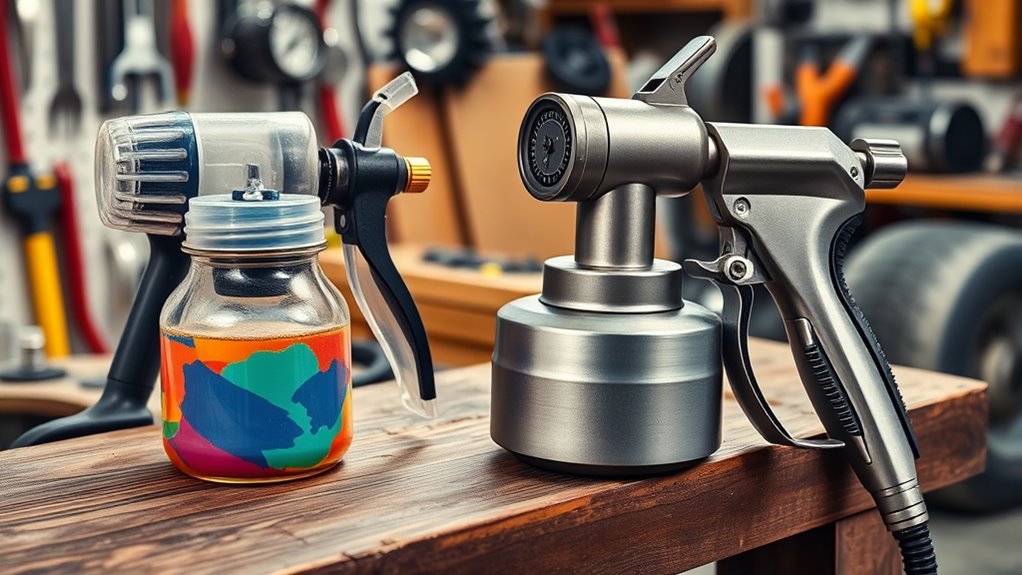
Whether you’re tackling a small DIY project or handling professional-grade jobs, choosing the right sprayer depends on your skill level and project needs. If you’re new to spraying, you’ll want something straightforward and easy to control. Handheld or pump sprayers are perfect for beginners—they’re lightweight, simple to operate, and require minimal setup. These sprayers work well for small projects like painting furniture, touch-up work, or applying sealants. They give you a good amount of control without overwhelming you with complex features, making them ideal for learning the basics.
Handheld sprayers are ideal for beginners doing small projects with easy control.
As you gain confidence and experience, you might consider upgrading to more advanced models. For example, a small electric or airless sprayer can handle larger areas and thicker coatings more efficiently. These sprayers require some practice to master but offer better coverage and faster application. If your projects involve multiple rooms, fences, or decks, investing in a mid-range sprayer with adjustable settings can save you time and effort. Look for models that are easy to clean and maintain, especially if you plan to switch between different materials or colors.
If you’re a professional or plan to do frequent, large-scale jobs, then you should consider high-capacity, professional-grade sprayers. These often come with features like variable pressure controls, larger tanks, and higher power, allowing for faster and more precise application. They may require more setup and a bit of technical know-how, but they’re built for durability and efficiency. Professionals also tend to prefer airless sprayers because they can handle thick paints and coatings with minimal overspray, producing a smooth finish on large surfaces.
Choosing the right sprayer also depends on your comfort level with handling equipment. If you’re hesitant about operating complex machinery, stick with simpler models until you’re comfortable. Conversely, if you’re enthusiastic to learn and ready to tackle bigger projects, investing in a more sophisticated sprayer will pay off in the long run. Always consider the type of project, the materials you’ll use, and how much time you’re willing to spend on setup and cleanup. Your skill level should guide you to the right tool—starting simple and upgrading as your confidence grows ensures you get the best results with less frustration. Additionally, understanding paint preparation and usage guidelines can significantly improve your outcomes and efficiency.
Frequently Asked Questions
What Safety Gear Is Necessary When Using Different Sprayers?
When using sprayers, you need safety gear like gloves, goggles, and a mask to protect your skin, eyes, and lungs from harmful chemicals. For more powerful or compressed sprayers, wear a respirator and long-sleeved clothing. Always read the label for specific safety recommendations. Proper gear helps prevent accidents and health risks, so make sure you’re fully protected before starting your spraying task.
How Long Does It Take to Learn Proper Sprayer Techniques?
Learning proper sprayer techniques can take anywhere from a few hours to a few days, depending on your experience and the complexity of the equipment. You’ll gain confidence quickly through hands-on practice, focusing on steady pressure, consistent movement, and correct spray patterns. Don’t rush—taking your time to practice guarantees even coverage and minimizes waste. With patience and practice, you’ll master the skills needed for safe and effective spraying.
Can I Upgrade My Sprayer as My Skills Improve?
Upgrading your sprayer is like changing gears in a car—you can adjust to better tools as your skills improve. Yes, you can upgrade your sprayer, especially if you find your current one limiting or want better precision. Look for models compatible with your existing setup, and consider features like adjustable pressure or nozzle options. Upgrading helps you work more efficiently and achieve professional results as you gain confidence and expertise.
What Maintenance Is Required for Various Types of Sprayers?
You need to regularly clean your sprayer after each use to prevent clogs and maintain performance. For pump sprayers, check seals and o-rings and lubricate them if needed. For compressed air or airless sprayers, inspect hoses and nozzles for damage, and flush the system with water or cleaning solution. Store your sprayer in a dry, protected place and perform periodic maintenance as recommended in the user manual to guarantee longevity.
Are There Specific Brands Recommended for Beginners or Professionals?
Brands bring bold benefits, so pick trusted names like Wagner, Graco, or Titan for reliability and quality. Beginners should look for user-friendly features, lightweight designs, and straightforward setups, often found in cheaper models from these brands. Pros might prefer more powerful, durable options with advanced features. Whichever you choose, make sure the brand offers solid support, service, and satisfaction, helping you spray smoothly and successfully every time.
Conclusion
Choosing the right sprayer depends on your skill level and project needs. Did you know that DIYers often save up to 50% compared to hiring professionals? By selecting a sprayer suited to your experience, you guarantee efficient, quality results without overspending. Whether you’re a beginner or pro, understanding your capabilities helps you make smarter choices. Invest in the right equipment, and you’ll enjoy smoother projects and better finishes—making your DIY journey more satisfying and successful.




